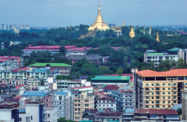To boost infrastructure investment, Myanmar is looking to kick-start a number of projects with China, its largest investor.
In mid-August State Counsellor Daw Aung San Suu Kyi met with Chinese Premier Li Keqiang to discuss economic relations, including resuming work on the suspended Myitsone dam project on Myanmar’s Ayeyawaddy River.
The high-level visit resulted in the Myanmar government commissioning a report on the Myitsone dam and another hydropower dam on the Thanlwin River. The report, which is scheduled for release in November, will detail the environmental impact of both dams, and recommend whether or not the projects should move forward.
Started in 2009 the $3.6bn Chinese-funded Myitsone dam project was initially scheduled for completion in 2019 and designed to yield 29.4bn KWh annually. According to media reports, China was slated to receive 90% of the generated power, but the project was halted in 2011 by former Myanmar president U Thien Sein.
Other China-backed infrastructure projects potentially jump-started by the recent diplomatic meeting include a bridge in Kunlong, some 30 km from Myanmar’s north-eastern border, which is designed to improve regional connectivity between Myanmar and China, as well as hospitals in Yangon and Mandalay, Myanmar’s two largest cities.
Since the late 1980s, Chinese investment in Myanmar has totalled $18bn, more than double the total contribution made by the UK ($4bn), South Korea ($3.5bn) and the US ($248m) during the same period.
China is also Myanmar’s largest trading partner, making up one-third of its total trade volume, which stood at $29.16bn in FY 2014/15.
Focus on increasing investment across the board
This latest development follows the unveiling in late July of the National League for Democracy government’s economic policy goals. The 12 goals – the details of which have not yet been released – focus on supporting agriculture, industry and infrastructure development, as well as increasing overall private sector participation and investment.
In mid-September, U Kyaw Win, Union Minister of Planning and Finance, noted the key areas for channelling investment into the country.
“Myanmar needs large-scale infrastructure investment – in power generation, transportation, special economic zones and industrial zones – to realise its long-term growth and development,” U Kyaw Win said at the 5th Euromoney Myanmar Global Investment Forum in Naypyidaw.
Room for improvement
Industry stakeholders have pointed to a number of strategies to increase investment levels, which have been in decline this year. Foreign direct investment (FDI) in the first four months of FY 2016/17, which started in April, decreased 85% year-on-year (y-o-y) to $380m, according to the Directorate of Investment and Company Administration (DICA).
U Kyaw Win Tun, director of DICA, attributed the decline in investment to the delayed formation of a new Myanmar Investment Commission (MIC), the body responsible for verifying and approving investment applications.
As of June the MIC had a backlog of some 100 projects. Of the projects pending approval, half of them were FDI projects, with a value of $2.3bn, according to press reports. Once the applications are approved, Myanmar could see an uptick in FDI.
Specific details on the recently unveiled economic goals could also act as an incentive for investors. In July U Thein Tun, chairman for the Tun Foundation Bank, told regional media that the government should develop a “detailed master plan” for economic development, one that included “annual implementation plans”.
Meanwhile, reliable country statistics could also attract investors, according to Luc de Waegh, managing partner of Myanmar-focused advisory firm West Indochina.
“Prior to the opening of the country, published reports were very detached from the reality on the ground,” he told OBG. “Investors were cautious about entering the country due to risks; however, the potential for growth has always been there.”
Optimistic outlook
Despite depressed investment figures in the beginning of the financial year, projections for Myanmar’s overall economic growth remain positive.
The IMF predicts Myanmar’s GDP will expand by 8% for FY 2016/17, up from an estimated 7% expansion in FY 2015/2016, as a result of a smooth political transition leading to increased investment and subsiding seasonal floods.
Furthermore, in mid-September the US announced it would lift economic sanctions against Myanmar, which had prevented investment for two decades, as well as add Myanmar to a list of developing countries receiving special trade status.
Myanmar aims to achieve $6bn in annual FDI between 2017 and 2020, raising the target to $8bn from 2021 through to 2030. For FY 2015/16, Myanmar received a record $9.5bn in FDI, according to DICA, despite muted investor sentiment ahead of elections.
Oxford Business Group is now on Instagram. Follow us here for news and stunning imagery from the more than 30 markets we cover.

